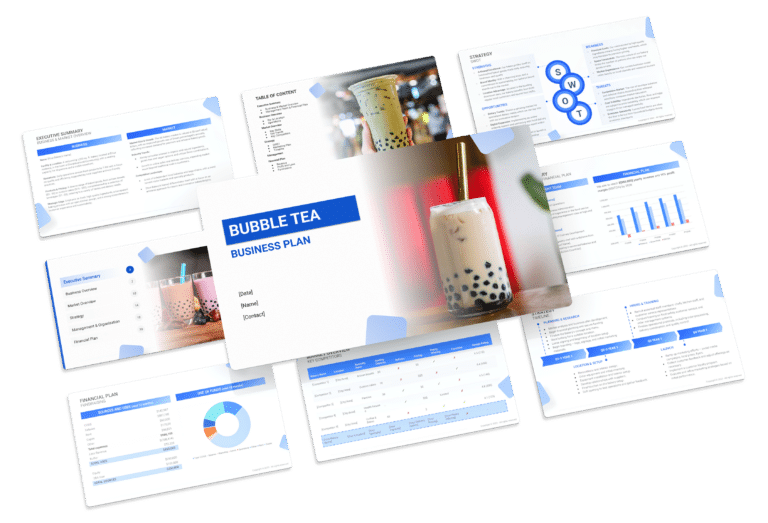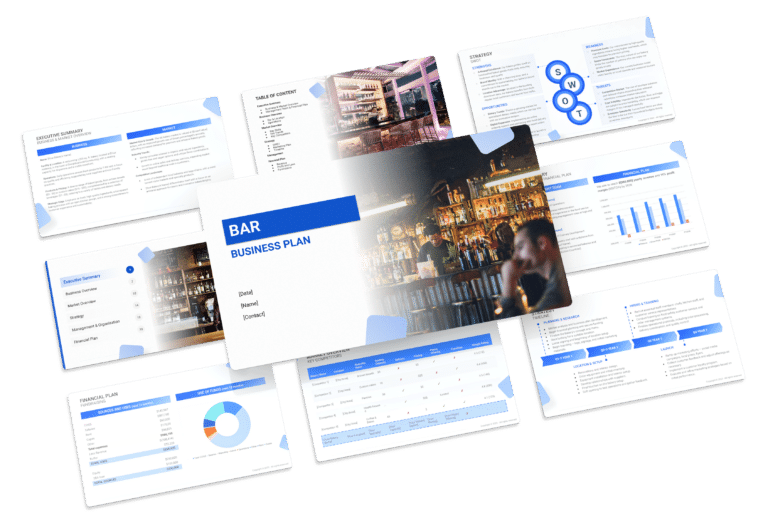How to Prepare a SWOT for a Bar (Example)

A SWOT analysis is pivotal in crafting a comprehensive business plan for a bar. SWOT (which stands for Strengths, Weaknesses, Opportunities, and Threats) provides a structured framework for bar owners to assess their business from various perspectives.
While strengths and weaknesses are internal factors under direct control, opportunities and threats are external elements that can significantly impact the bar’s success. For instance, strengths may include a signature drink menu and a prime downtown location, while weaknesses could involve limited seating or outdated decor.
This article will delve into specific examples of strengths and weaknesses, opportunities and weaknesses. Let’s dive in!

Strengths
Discover the inherent strengths that can elevate your bar services and create a spirited haven for patrons.
- Expert Mixology and Craft Cocktails: A skilled team of mixologists and a diverse range of craft cocktails distinguish your bar, creating a unique and memorable drinking experience.
- Example: Training staff in advanced mixology techniques and curating a signature cocktail menu showcase expertise and entice discerning customers.
- Inviting Ambiance and Aesthetic Appeal: A well-designed and inviting ambiance enhances the overall bar experience, attracting patrons and encouraging repeat visits.
- Example: Implementing stylish decor, comfortable seating arrangements, and ambient lighting contributes to a welcoming atmosphere, creating a destination-worthy space.
- Event Hosting and Entertainment: Offering event hosting services and entertainment options, such as live music or themed nights, adds a dynamic element to the bar experience.
- Example: Organizing live music events, hosting themed parties, and collaborating with local performers create a vibrant and lively atmosphere, enticing a diverse clientele.
- Strategic Location and Accessibility: A strategic location with easy accessibility contributes to foot traffic and ensures your bar is conveniently located for patrons.
- Example: Choosing a location with high footfall, close proximity to public transportation, and ample parking facilities enhances accessibility and visibility.
Weaknesses
Identifying weaknesses is crucial for improving operational efficiency and providing a seamless bar experience.
- Staff Turnover and Training Challenges: High staff turnover and challenges in training new personnel may impact service consistency and customer satisfaction.
- Example: Implementing comprehensive training programs, offering employee incentives, and creating a positive work environment contribute to staff retention and performance.
- Limited Beverage Selection: A limited beverage selection may restrict the variety offered to patrons, potentially limiting the appeal of the bar.
- Example: Regularly updating the beverage menu, introducing seasonal specials, and incorporating diverse spirits and mixers ensure a dynamic and enticing selection.
- Dependence on Seasonal Trends: Relying heavily on seasonal trends may result in fluctuations in customer traffic and revenue.
- Example: Diversifying the menu with timeless classics and incorporating seasonal trends in moderation ensure a balanced and appealing beverage selection throughout the year.
- Competitive Pricing Pressures: Intense competition in the bar industry may lead to pricing pressures, impacting profit margins.
- Example: Offering happy hour promotions, loyalty programs, and unique drink packages attract customers without compromising the overall profitability.
Opportunities
Explore the opportunities that can propel your bar services to new heights and keep patrons coming back for more.
- Craft Beer and Artisanal Spirits Trend: The growing trend of craft beer and artisanal spirits presents an opportunity to curate a unique and specialized beverage menu.
- Example: Collaborating with local breweries, featuring craft beer flights, and incorporating artisanal spirits in cocktails align with current beverage trends.
- Digital Marketing and Social Media Engagement: Leveraging digital marketing and social media platforms enhances visibility and engages with a tech-savvy audience.
- Example: Running targeted social media campaigns, creating visually appealing content, and encouraging user-generated content through hashtags boost online presence.
- Collaborations and Partnerships: Collaborating with local businesses, influencers, or hosting joint events expands your network and attracts diverse clientele.
- Example: Partnering with local food vendors for pop-up events, collaborating with influencers for promotions, and hosting joint events with neighboring businesses enhance community engagement.
- Private Events and Catering Services: Offering private event hosting and catering services extends your revenue streams beyond regular business hours.
- Example: Promoting event packages, creating customizable catering menus, and actively marketing to local businesses and event planners attract private event bookings.
Threats
Anticipate and mitigate potential threats to ensure the longevity and success of your bar services.
- Changing Consumer Preferences: Evolving consumer preferences and emerging beverage trends may impact the popularity of certain drinks or styles.
- Example: Regularly updating the menu based on customer feedback, conducting market research, and introducing new offerings align the bar with changing preferences.
- Regulatory Challenges and Licensing Issues: Adapting to evolving regulations and addressing licensing challenges is essential to avoid disruptions in operations.
- Example: Staying informed about regulatory changes, maintaining transparent communication with regulatory authorities, and promptly addressing compliance issues ensure a smooth operational flow.
- Economic Downturn and Spending Constraints: Economic downturns and spending constraints may impact discretionary spending on non-essential services like bar outings.
- Example: Introducing cost-effective promotions, creating value-driven packages, and implementing loyalty programs encourage customer retention during economic challenges.
- Negative Online Reviews and Reputation Damage: Negative online reviews or reputation damage can significantly impact the credibility and patronage of the bar.
- Example: Implementing a proactive approach to address customer concerns, encouraging positive reviews, and showcasing satisfied customer experiences on social media counteract the impact of negativity.





